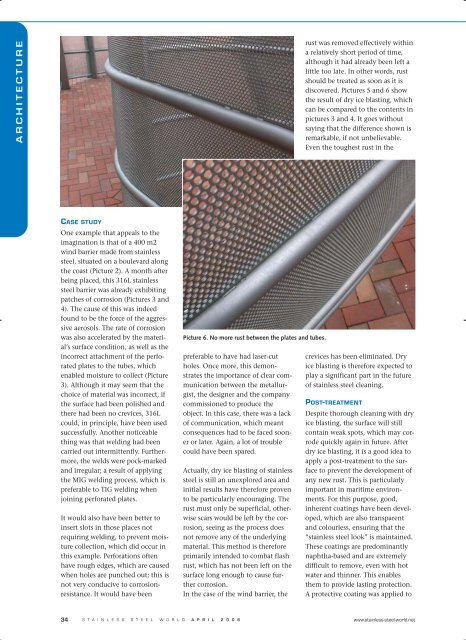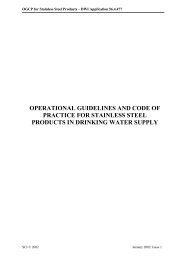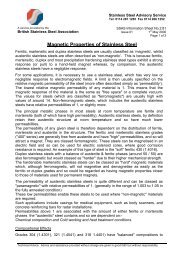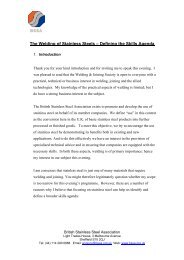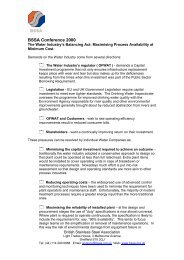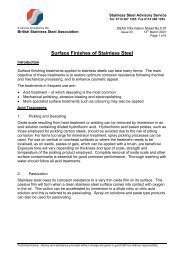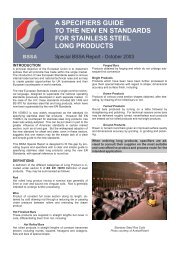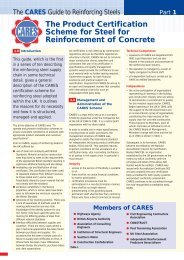Dry ice blasting of stainless steel - British Stainless Steel Association
Dry ice blasting of stainless steel - British Stainless Steel Association
Dry ice blasting of stainless steel - British Stainless Steel Association
You also want an ePaper? Increase the reach of your titles
YUMPU automatically turns print PDFs into web optimized ePapers that Google loves.
ARCHITECTURE<br />
rust was removed effectively within<br />
a relatively short period <strong>of</strong> time,<br />
although it had already been left a<br />
little too late. In other words, rust<br />
should be treated as soon as it is<br />
discovered. Pictures 5 and 6 show<br />
the result <strong>of</strong> dry <strong>ice</strong> <strong>blasting</strong>, which<br />
can be compared to the contents in<br />
pictures 3 and 4. It goes without<br />
saying that the difference shown is<br />
remarkable, if not unbelievable.<br />
Even the toughest rust in the<br />
CASE STUDY<br />
One example that appeals to the<br />
imagination is that <strong>of</strong> a 400 m2<br />
wind barrier made from <strong>stainless</strong><br />
<strong>steel</strong>, situated on a boulevard along<br />
the coast (Picture 2). A month after<br />
being placed, this 316L <strong>stainless</strong><br />
<strong>steel</strong> barrier was already exhibiting<br />
patches <strong>of</strong> corrosion (Pictures 3 and<br />
4). The cause <strong>of</strong> this was indeed<br />
found to be the force <strong>of</strong> the aggressive<br />
aerosols. The rate <strong>of</strong> corrosion<br />
was also accelerated by the material’s<br />
surface condition, as well as the<br />
incorrect attachment <strong>of</strong> the perforated<br />
plates to the tubes, which<br />
enabled moisture to collect (Picture<br />
3). Although it may seem that the<br />
cho<strong>ice</strong> <strong>of</strong> material was incorrect, if<br />
the surface had been polished and<br />
there had been no crev<strong>ice</strong>s, 316L<br />
could, in principle, have been used<br />
successfully. Another not<strong>ice</strong>able<br />
thing was that welding had been<br />
carried out intermittently. Furthermore,<br />
the welds were pock-marked<br />
and irregular; a result <strong>of</strong> applying<br />
the MIG welding process, which is<br />
preferable to TIG welding when<br />
joining perforated plates.<br />
It would also have been better to<br />
insert slots in those places not<br />
requiring welding, to prevent moisture<br />
collection, which did occur in<br />
this example. Perforations <strong>of</strong>ten<br />
have rough edges, which are caused<br />
when holes are punched out; this is<br />
not very conducive to corrosionresistance.<br />
It would have been<br />
Picture 6. No more rust between the plates and tubes.<br />
preferable to have had laser-cut<br />
holes. Once more, this demonstrates<br />
the importance <strong>of</strong> clear communication<br />
between the metallurgist,<br />
the designer and the company<br />
commissioned to produce the<br />
object. In this case, there was a lack<br />
<strong>of</strong> communication, which meant<br />
consequences had to be faced sooner<br />
or later. Again, a lot <strong>of</strong> trouble<br />
could have been spared.<br />
Actually, dry <strong>ice</strong> <strong>blasting</strong> <strong>of</strong> <strong>stainless</strong><br />
<strong>steel</strong> is still an unexplored area and<br />
initial results have therefore proven<br />
to be particularly encouraging. The<br />
rust must only be superficial, otherwise<br />
scars would be left by the corrosion,<br />
seeing as the process does<br />
not remove any <strong>of</strong> the underlying<br />
material. This method is therefore<br />
primarily intended to combat flash<br />
rust, which has not been left on the<br />
surface long enough to cause further<br />
corrosion.<br />
In the case <strong>of</strong> the wind barrier, the<br />
crev<strong>ice</strong>s has been eliminated. <strong>Dry</strong><br />
<strong>ice</strong> <strong>blasting</strong> is therefore expected to<br />
play a significant part in the future<br />
<strong>of</strong> <strong>stainless</strong> <strong>steel</strong> cleaning.<br />
POST-TREATMENT<br />
Despite thorough cleaning with dry<br />
<strong>ice</strong> <strong>blasting</strong>, the surface will still<br />
contain weak spots, which may corrode<br />
quickly again in future. After<br />
dry <strong>ice</strong> <strong>blasting</strong>, it is a good idea to<br />
apply a post-treatment to the surface<br />
to prevent the development <strong>of</strong><br />
any new rust. This is particularly<br />
important in maritime environments.<br />
For this purpose, good,<br />
inherent coatings have been developed,<br />
which are also transparent<br />
and colourless, ensuring that the<br />
“<strong>stainless</strong> <strong>steel</strong> look” is maintained.<br />
These coatings are predominantly<br />
naphtha-based and are extremely<br />
difficult to remove, even with hot<br />
water and thinner. This enables<br />
them to provide lasting protection.<br />
A protective coating was applied to<br />
34<br />
S T A I N L E S S S T E E L W O R L D A P R I L 2 0 0 6 www.<strong>stainless</strong>-<strong>steel</strong>-world.net


